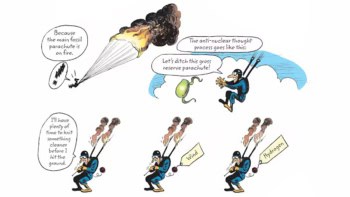To survive, polar bears need to gain weight, not lose it. With a longer summer and less sea ice, it’s a lot harder to do that.
Polar bears may be having a harder time than anybody thought. Biologists who monitored the hunting habits of the Arctic’s iconic predator found that bears have a faster metabolism – that is, they need high-energy foods more often – and are likely to lose weight just when they should be getting fat and ready for the winter.
Ursus maritimus is famous for going without food for long periods and then making up for it when the going is good. And for a polar bear, the going only gets good when there is a lot of sea ice and rich pickings among the seal population.
But US Geological Survey scientists who fitted monitors and video cameras to nine female polar bears for periods of 8 to 11 days and then tracked them on the ice of the Beaufort Sea, north of Alaska, report that five of their “volunteers” had lost weight.
Four of them had lost 10% of their body mass: that is, they could not catch seals often enough to put on weight. One had even lost muscle tissue.
The study confirms that bears are vulnerable to climate change. Sea ice minimum levels are falling at the rate of 14% a decade in the Arctic, and polar bears have been feeling the loss.
But because the bear is a sit-and-wait predator, hunting ringed seals or bearded seals for preference as they haul out onto the ice, biologists had assumed that a resting bear would have a low metabolic rate. Not so, according to a new study in the journal Science.
The bears are active about one third of the time and use energy swimming and walking. The tests and observations were made during the period from April to July when bears catch most of their prey to store up the body fat they need.
In fact the instrument readings and tests of urine and blood samples told the scientists that the metabolic rate of a bear was more than 50% above previous calculations.
So a female seal out on the ice in the polar spring would need to eat one adult ringed seal, or three subadults, or 19 newborn seal pups, every 10 or 12 days just to stay as she was, at the same bodyweight.
Fall explained
But to succeed and breed in the winter, a female would ideally need to consume so much seal blubber that her fat levels matched her lean body mass. In April on the Beaufort Sea between 2014 and 2016, the bears in the test study had no great luck.
“We found that polar bears actually have much higher energy demands than predicted. They need to be catching a lot of seals,” said Anthony Pagano, a doctoral researcher from the University of California Santa Cruz, and a wildlife biologist with the US Geological Survey, who led the research.
Bear population in the Beaufort Sea has fallen by about 40% in the last decade. Now, biologists are beginning to see why.
“We now have the technology to learn how they are moving on the ice, their activity patterns and their energy needs, so we can better understand the implications of these changes we are seeing on the sea ice,” he said. – Climate News Network
• This report was first published in Climate News Network



